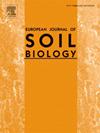解读低、高营养水平下葡萄糖诱导土壤启动效应的微生物机制
IF 3.3
2区 农林科学
Q1 ECOLOGY
引用次数: 0
摘要
土壤启动效应是指不稳定碳输入对土壤有机质分解的影响,在碳储量中起着重要作用。研究基质诱导的土壤启动效应和相关的微生物机制,特别是在养分梯度下,是理解农业土壤中碳过程和潜在积累的核心。因此,通过7天的实验室培养来评估13C标记葡萄糖在土壤中添加高(TH)和低营养(TL)诱导的启动效应。同时,采用DNA-SIP结合宏基因组技术鉴定土壤启动效应的核心微生物群和功能区系。本研究发现:1)TL处理的土壤启动效应明显大于TH处理;2)TL中较大的土壤启动效应可能是由k策略微生物主导的n挖掘过程驱动的,而TH中较少的土壤启动效应可能是由r策略微生物主导的共代谢引起的。此外,通过霰弹枪测序分析了微生物群落的功能变化。KEGG、EggNOG和CAZymes均显示,与TH相比,TL中编码土壤有机碳分解纤维素酶的功能基因(如GH13_10和GH77)的相对丰度更高,说明TL中较高的启动效应主要是由于养分对微生物需求的限制。本研究揭示了低、高营养水平下葡萄糖诱导土壤启动效应的主要微生物类群及其功能。本文章由计算机程序翻译,如有差异,请以英文原文为准。
Deciphering the microbial mechanisms underlying glucose induced soil priming effects under low and high nutrient levels
Soil priming effect, which refers to the impact of labile carbon inputs on the decomposition of soil organic matter, plays a significant role in carbon storage. Investigating substrate induced soil priming effects and the involved microbial mechanisms, particularly under nutrients gradient, is central to the understanding of carbon processes and potential accrual in agriculture soil. Thus, a 7 days laboratory incubation was conducted to assess 13C labeled glucose induced priming effects in soil receiving the high (TH) and low nutrient (TL) addition. Also, DNA-SIP coupled with metagenomic were adopted to identify the core microbial groups and functional guild responsible for soil priming effects. Here, we found that i) soil priming effects were significantly larger in TL treatment than in the TH treatment, and ii) the larger priming in TL was likely driven by N-mining processes dominated by K-strategy microbes, whereas less priming in TH might be explained by co-metabolism led by r-strategy microbes. Additionally, functional changes of microbial community were revealed by Shotgun sequencing. Both KEGG, EggNOG and CAZymes showed the relative abundance of the functional genes (e.g., GH13_10 and GH77) encoding cellulase enzymes involved in soil organic carbon decomposition were more abundant in TL compared to TH, suggesting higher priming effects in TL was mainly due to the nutrient constraints on microbial demands. This study revealed the main microbial groups and their functions in glucose induced soil priming effects under low and high nutrient levels.
求助全文
通过发布文献求助,成功后即可免费获取论文全文。
去求助
来源期刊

European Journal of Soil Biology
环境科学-生态学
CiteScore
6.90
自引率
0.00%
发文量
51
审稿时长
27 days
期刊介绍:
The European Journal of Soil Biology covers all aspects of soil biology which deal with microbial and faunal ecology and activity in soils, as well as natural ecosystems or biomes connected to ecological interests: biodiversity, biological conservation, adaptation, impact of global changes on soil biodiversity and ecosystem functioning and effects and fate of pollutants as influenced by soil organisms. Different levels in ecosystem structure are taken into account: individuals, populations, communities and ecosystems themselves. At each level, different disciplinary approaches are welcomed: molecular biology, genetics, ecophysiology, ecology, biogeography and landscape ecology.
 求助内容:
求助内容: 应助结果提醒方式:
应助结果提醒方式:


